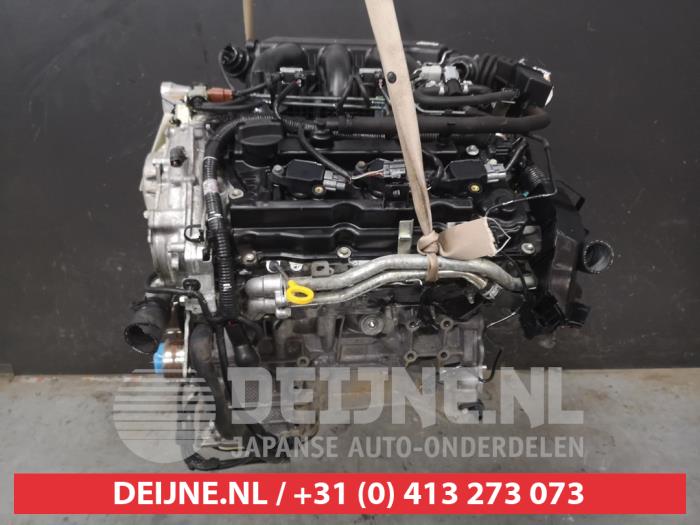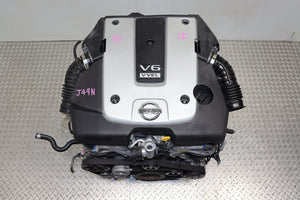How to Troubleshoot Common VQ35 Engine Problems and Save on Repairs
All Concerning the VQ35 Nissan Murano Engine: Performance, Dependability, and Maintenance Tips
The VQ35 engine in the Nissan Murano stands out as a significant part in the world of automobile design, integrating an equilibrium of performance and Reliability that appeals to several drivers. With its 3.5-liter V6 setup, this engine not just provides good horse power and torque but likewise flaunts a credibility for sturdiness.
Introduction of the VQ35 Engine
Developed as component of Nissan's VQ engine family, the VQ35 engine is a 3.5-liter V6 powerplant that has actually garnered a track record for its balance of performance and performance. Introduced in the very early 2000s, this engine has been utilized in various Nissan and Infiniti designs, consisting of the Murano, Altima, and 350Z. Its layout integrates an aluminum alloy block and DOHC (Double Expenses Camshaft) setup, which add to its lightweight and compact nature.
The VQ35 engine includes a 60-degree V-angle and makes use of variable shutoff timing innovation, enhancing both power delivery and fuel performance. With a maximum result commonly around 280 horse power and 270 lb-ft of torque, it gives adequate performance for a mid-sized SUV. The engine is likewise recognized for its smooth operation and reasonably reduced noise levels, making it appropriate for family-oriented lorries like the Murano.
Along with its performance qualities, the VQ35 engine is identified for its Reliability. Numerous owners report very little concerns with regular maintenance, which is crucial for making certain durability and ideal performance. On the whole, the VQ35 engine stands out as a well-engineered option in the vehicle market.
Efficiency Attributes
The efficiency attributes of the VQ35 engine are notable, particularly in its application within the Nissan Murano. This 3.5-liter V6 engine is engineered to deliver a well balanced mix of power and performance, generating about 245 horse power and 246 lb-ft of torque. Such outcome supplies the Murano with responsive acceleration and a positive driving experience, making it appropriate for both city and freeway atmospheres.
The VQ35 uses a twin overhead camshaft (DOHC) layout and functions variable valve timing, enhancing engine performance and efficiency across numerous RPM varieties. This translates to smoother power distribution and boosted fuel economy, with the Murano attaining around 20 mpg in the city and 28 mpg on the freeway.
Furthermore, the engine's light-weight aluminum building contributes to the total agility of the Murano, guaranteeing that the vehicle takes care of well while keeping stability. The integration of innovative modern technologies, such as the electronic throttle control, further refines the driving experience, enabling exact throttle action. Collectively, these performance features make the VQ35 engine an extensive option for those looking for a flexible and capable midsize crossover.
Dependability Analysis
Commonly related to for its durability, the VQ35 engine in the Nissan Murano has actually made a reputation for Dependability amongst owners and vehicle professionals alike. This engine is made with a robust design that sustains long-term performance, making it a preferred choice for those seeking a reputable car.

In Addition, the VQ35 engine advantages from sophisticated technologies, consisting of an effective variable shutoff timing system that enhances engine efficiency and lowers anxiety on components. This converts into fewer malfunctions and a typically reduced incidence of fixings. Numerous proprietors report high mileage without considerable issues, strengthening the engine's credibility.
Usual Issues
While the VQ35 engine is commemorated for its overall Reliability, it is not without its share of usual issues that proprietors might experience. One frequent worry entails the engine's oil usage. Several VQ35 owners report too much oil burning, which can lead to low oil degrees and potential engine damage otherwise addressed immediately.
Another problem refers to the timing chain. vq35. The VQ35 is equipped with a timing chain rather than a belt, which typically needs much less upkeep, some proprietors have experienced chain stretch and linked rattling sounds, particularly in older designs. This can cause extreme engine damage if not visite site diagnosed early
Furthermore, the engine may experience from coolant leakages, specifically at the consumption manifold. Such leakages can bring about overheating and succeeding engine failing if not managed.
Finally, the mass airflow sensor (MAF) can fail, causing performance issues such as rough idling and a reduction in fuel effectiveness. vq35.

Maintenance Tips
Routine upkeep is vital for ensuring the durability and optimum performance of the VQ35 Nissan Murano engine. To accomplish this, it is crucial to stick to a normal oil change routine, preferably every 5,000 to 7,500 miles, using premium artificial oil that satisfies Nissan requirements. This helps maintain engine lubrication and efficiency.
Additionally, surveillance and changing the air filter at recommended periods can improve engine efficiency and horse power. The gas system must additionally be checked regularly, with fuel injectors cleaned up to avoid accumulation that could affect performance.
Checking and preserving the cooling system is crucial; make certain the coolant is changed according to the manufacturer's schedule to avoid overheating and engine damage. The timing belt must be changed every 105,000 miles to prevent tragic engine failing.
Last but not least, regularly inspecting recommended you read belts and hoses for wear can avoid unexpected break downs. Keeping up with these maintenance suggestions will not just boost the Dependability of your VQ35 engine however likewise contribute to its overall performance, guaranteeing a smooth driving experience for many years to come.
Conclusion
The VQ35 engine in the Nissan Murano exhibits a balance of efficiency and Reliability, making it a preferred option among mid-size SUVs. With its noteworthy horsepower and torque figures, this powerplant supplies an engaging driving experience. Routine maintenance, including prompt oil adjustments and system assessments, is necessary to make certain long life and ideal performance. Understanding of potential concerns additionally boosts ownership complete satisfaction, solidifying the VQ35's online reputation as a sturdy and effective engine.
The VQ35 engine in the Nissan Murano stands out as a substantial component in the world of automotive design, combining a balance of efficiency and Reliability that charms to several chauffeurs.Created as part of Nissan's VQ engine household, the VQ35 engine is a 3.5-liter V6 powerplant that has actually gathered an online reputation for its balance of efficiency and performance - vq35.Additionally, the VQ35 engine advantages from innovative technologies, consisting of a reliable variable valve timing system that enhances engine effectiveness and reduces anxiety on parts.Regular maintenance is crucial for guaranteeing the durability and optimum performance of the VQ35 Nissan Murano engine.The VQ35 engine in the Nissan Murano exemplifies a balance of performance and Dependability, making it a popular selection among mid-size SUVs